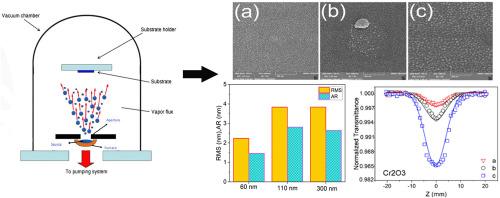d-d 过渡电子和厚度变化对激发态光学特性的影响:Cr2O3 薄膜的非线性光学特性分析
IF 3.3
3区 物理与天体物理
Q2 OPTICS
引用次数: 0
摘要
测量了热沉积法沉积的不同厚度的 Cr2O3 薄膜的结构、形态、线性和非线性光学特性。通过 XRD、FESEM 和 AFM 图像确定的薄膜结构和形态参数与这些介质的线性和非线性光学特性进行了比较。制备薄膜的带隙是通过 DRS 光谱获得的。利用带隙能值计算了电子有效质量(me∗/m0)、线性折射率(n0)、光学静态和高频介电常数(ε0 , ε∞)值。增加薄膜厚度会导致带隙减小、有效值增加、纳米粒子尺寸增大以及薄膜的非线性响应。厚度为 300 nm 的 Cr2O3 的 n2 和 β 值较高,分别为 10-5 cm2/W 和 10-1 cm/W。非线性数据表明,在不同厚度下观察到的非线性响应波动归因于受激光辐射影响的 d-d 转变和平衡电子的带内散射。所分析薄膜材料的折射非线性值大大提高,表明它们在光电设备中具有实际应用的潜力。本文章由计算机程序翻译,如有差异,请以英文原文为准。

Influence of d-d transition electrons and thickness variations on the excited-state optical properties: Nonlinear optical characterization of Cr2O3 thin film
The structural, morphological, linear, and nonlinear optical properties of Cr2O3 thin films with different thicknesses deposited by the thermal deposition, were measured. The structural and morphological parameters of films, determined by XRD, FESEM, and AFM images, are compared to the linear and nonlinear optical characteristics of these media. The bandgap of prepared thin films was obtained from DRS spectra. The electron effective mass (), linear refractive index (), optical static, and high frequency dielectric constant ( , ) values were calculated by using the band gap energy values. Increasing the thicknesses of thin films causes to decrease the band gap, an increase RMS, increase the size of nanoparticles and the nonlinear responses of thin films. The high magnitude of n2, and β belonged to the Cr2O3 (300 nm-thickness) in the order of 10−5 cm2/W, and 10−1 cm/W respectively. The fluctuations in nonlinear responses observed at different thicknesses are attributed to d-d transitions and intraband scattering of equilibrium electrons influenced by laser radiation, as indicated by the nonlinearity data. The considerably elevated refractive non-linearity values in the analyzed film materials suggest their potential for practical applications in optoelectronic devices.
求助全文
通过发布文献求助,成功后即可免费获取论文全文。
去求助
来源期刊

Journal of Luminescence
物理-光学
CiteScore
6.70
自引率
13.90%
发文量
850
审稿时长
3.8 months
期刊介绍:
The purpose of the Journal of Luminescence is to provide a means of communication between scientists in different disciplines who share a common interest in the electronic excited states of molecular, ionic and covalent systems, whether crystalline, amorphous, or liquid.
We invite original papers and reviews on such subjects as: exciton and polariton dynamics, dynamics of localized excited states, energy and charge transport in ordered and disordered systems, radiative and non-radiative recombination, relaxation processes, vibronic interactions in electronic excited states, photochemistry in condensed systems, excited state resonance, double resonance, spin dynamics, selective excitation spectroscopy, hole burning, coherent processes in excited states, (e.g. coherent optical transients, photon echoes, transient gratings), multiphoton processes, optical bistability, photochromism, and new techniques for the study of excited states. This list is not intended to be exhaustive. Papers in the traditional areas of optical spectroscopy (absorption, MCD, luminescence, Raman scattering) are welcome. Papers on applications (phosphors, scintillators, electro- and cathodo-luminescence, radiography, bioimaging, solar energy, energy conversion, etc.) are also welcome if they present results of scientific, rather than only technological interest. However, papers containing purely theoretical results, not related to phenomena in the excited states, as well as papers using luminescence spectroscopy to perform routine analytical chemistry or biochemistry procedures, are outside the scope of the journal. Some exceptions will be possible at the discretion of the editors.
 求助内容:
求助内容: 应助结果提醒方式:
应助结果提醒方式:


